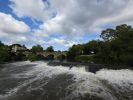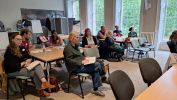Spaces and territories: Exploring time and place in the streets of Bath
Philippe Lecrivain of Yerevan-based NGO Educational & Cultural Bridges reflects on notions of space and territory, as he explores a city where past and present co-exist.
I spent a month at the University of Bath in July 2022. The University’s campus, located on a hill and on the outskirts of the historic city of Bath, is a pleasant place to do research. The city, a UNESCO World heritage city since 1987, offers a very interesting reflection on ideas of space and territory. The several ‘spaces’ of the city seem to have a concrete destination. First of all, there is the historical space and if we study the history of the city, we learn that it was considered to be a holy place by the Celts and dedicated to the cult of the Goddess Sulis. The Romans, following their invasion, named the city Aquae Sulis because of the thermal waters that gushed - and continues to gush to this day. The busiest space in the city is the one dedicated to Roman Baths. Following the withdrawal of Roman troops at the beginning of the 6th century, the baths fell into disrepair and were lost under sand and mud until their rediscovery in the 19th century. Now preserved, inside they offer 5 spaces completely defined in a way so characteristic of Roman baths: the apodyterium (the changing room) and the palestra (room intended for physical exercise), the sudatorium (sweating room), caldarium (pool with hot water), tepidarium (warm bath) and frigidarium (pool with cold water).
Considered a spa resort in Roman times, the city of Bath became an important ecclesiastical centre at the very beginning of the Middle Ages and Bath Abbey, rebuilt several times, is proof of this. The 17th century saw the ‘renaissance’ of the city of Bath: English aristocracy, attracted by the healing properties of the thermal waters, moved in. New districts were built offering architectural feats such as the Royal Crescent and the Circus. Out of personal interest, I was interested in knowing if it was still possible to acquire an apartment in the Royal Crescent and yes, it is quite possible to buy a personal space in the Royal Crescent (at a price!). The row of identical gold-cream coloured facades alternates at times with very pretty Italian-style villas and the feeling of being in Italy overwhelms us when we go up Bathwick Hill from the city centre to the University campus.
Spaces for relaxation and for sports occupy an important place in the city’s parks territory. Although public, some parts of the parks (or the whole park) can be used for weddings, civil partnerships, vow renewals and receptions. And as July is a very good month for weddings, I attended several at Parade Garden and Royal Vicotria Park. Each park has well-defined spaces, offering a play area for children, bandstands, a botanical garden and sports fields dedicated to rugby and cricket. The famous Thermae Bath Spa which is built right next to the Roman Baths offers an experience equal to that of the beginning of the first millennium.
The cultural space of the city is very rich with its multiple museums. I visited several: The Holburne Museum (exhibitions of historical and contemporary art), Herschel Museum of Astronomy (from the garden of this house William Herschel discovered Uranus in 1781), the American Museum and Gardens (the only museum of Americana outside the US, with a remarkable collection of folk, decorative and cultural objects showing the diverse and complex nature of American traditions), and N°1 Royal Crescent which offers a discovery of family life in Georgian Bath. Bath’s Fashion Museum is one of the world’s great museum collections of historical and contemporary dress, showcasing fashions from the 1600s to the present day, while the Museum of Bath at Work exposes the past, present and future of Bath’s working life from Roman tourism to the industries of the 21st century. And of course, The Jane Austen Centre, which inscribes the personal space of Bath’s most famous resident.
I conclude with a visit to Bath City Farm, which was joyful - I discovered woolly pigs and an absolutely breathtaking view of the whole city of Bath!
Philippe Lecrivain has been a specialist in insurance law for almost 20 years. His domain of expertise is the compensation of victims of bodily injury, whatever the type of accident. He has been actively involved in the work of NGO Educational and Cultural Bridges since its inception, where he oversees the effective management of association activities. The history of the twentieth century is one of his interests.




































